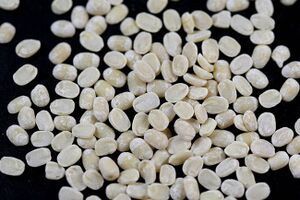

Urad, also referred to as urad dal, udad dal, urd bean, urd, urid, black matpe bean, black gram, black lentil (not to be confused with the much smaller true black lentil (Lens culinaris)), or white lentil (Vigna mungo), is a beans grown in southern Asia. It is largely used to make dal from the whole or split, de-husked seeds. It, along with the mung bean, was placed in Phaseolus but has been transferred to Vigna. It was at one point considered to belong to the same species as the mung bean.
Black gram originated in India where it has been in cultivation from ancient times and is one of the most highly prized pulses of India. It has also been introduced to other tropical areas mainly by Indian immigrants.
It is an erect, sub-erect or trailing, densely hairy annual herb. The tap root produces a branched root system with smooth, rounded nodules. The pods are narrow, cylindrical and up to 6 cm long. The beans are boiled and eaten whole or after splitting into dal; prepared like this it has an unusual mucilaginous texture. Ground into flour or paste, it is also extensively used in culinary preparation like dosa, idli, vada, and papad. When used this way, the white lentils are usually used. The white lentils are called "ulundhu" (உளுந்து) in Tamil.
It is very nutritious and is recommended for diabetics, as are other pulses. It is very popular in Punjabi cuisine of India and Pakistan where it is known as "maash".
The product sold as "black lentil" is usually the whole urad bean or urad dal. The product sold as "white lentil" is the same lentil with the black skin removed.
How to cook urad beans in a pressure cooker
Use this basic guide if you do not have a specific recipe
- Pick through the beans and discard any discoloured beans or loose skins
- Soak in cold water for a minimum of the time shown, soaking overnight is usually the best way to achieve this
- Change soaking water a few times if possible
- Never cook the beans in the water they were soaked in
- Rinse the beans well at the end of the soaking period
- Ensure the pressure cooker is at least a quarter full
- Never fill the pressure cooker more than half full
- Always cover the beans with at least 5 cm (2") water
- Add 2 tablespoons of vegetable oil to the water - this reduces foaming
- Allow the pressure cooker to get to the required pressure and then begin timing
- Use the specified pressure release method - this is the natural method in the case of dried beans or pulses
- A bean is usually perfectly cooked when it can be easily squashed between your forefinger and thumb
- If the beans are not sufficiently cooked, return to pressure, cook for another 3 minutes and allow the pressure to reduce using the natural method.
Re-check that the beans are cooked to your liking.
| BEAN VARIETY | COLD WATER SOAK TIME minimum period |
PRESSURE COOKING TIME | COOKING PRESSURE High = 15 psi Medium = 10 psi Low = 5 psi |
PRESSURE RELEASE METHOD |
| Black urad beans | None | 7 minutes | High | Natural |
See also
- Instructions and pressure cooking times for more than 20 types of bean
- Detailed index and cooking information for more than 20 bean varieties
- Pressure cooking information and pressure cooking recipes
Find recipes that contain 'Urad beans'
#uradbeans #pressurecooker #beans #mungbean #naturalmethod #lentil #pulses #nutsgrainsandseeds #naturalpressurereleasemethod #flour #pressurereleasemethod